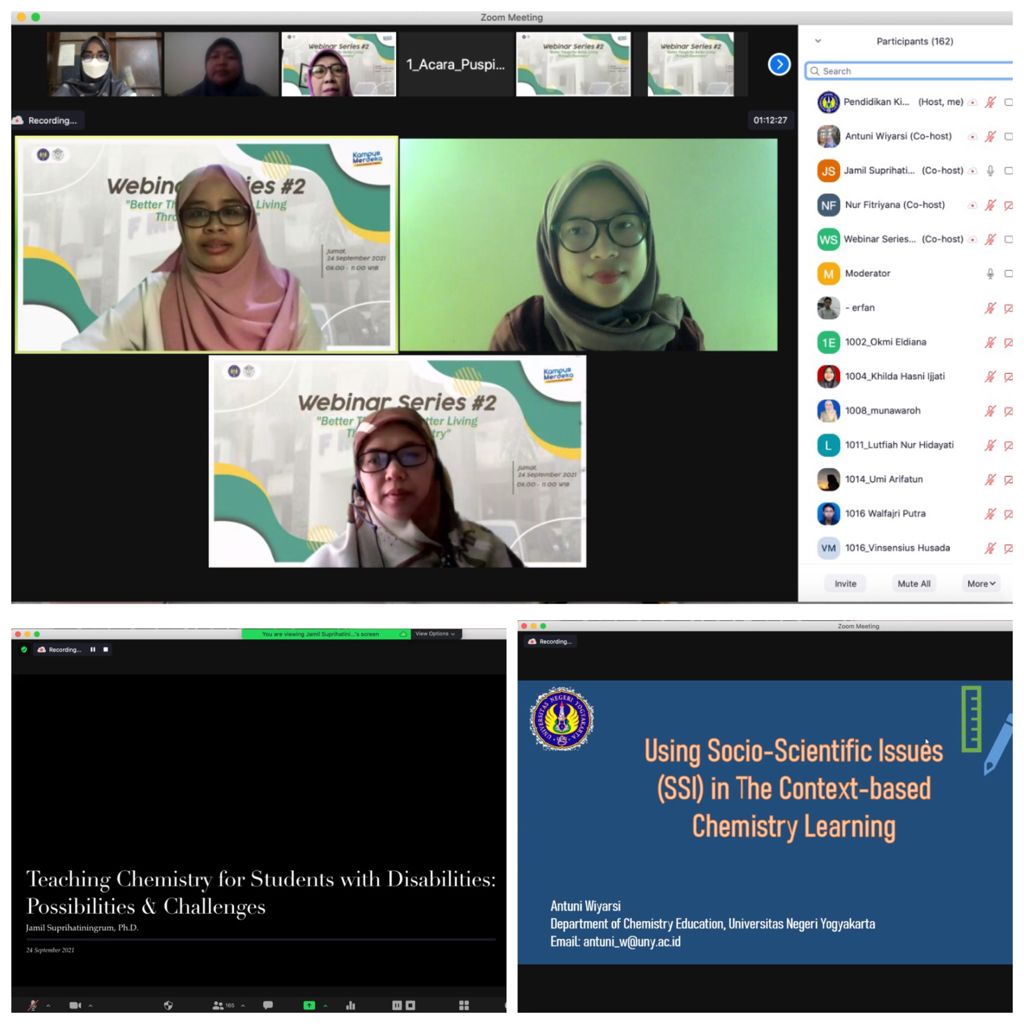You are here
Chemistry Education Department - Webinar Series #2

The Department of Chemistry Education, Faculty of Mathematics and Natural Sciences, UNY has held an online Webinar Series #2 on Friday, September 24, 2021. This activity was attended by a number of 179 participants from among lecturers, teachers, students, etc. There were two resource persons who were invited to fill the webinar series #2 today, namely Mrs. Jamil Suprihatiningrum, Ph.D. who is a lecturer in the Chemical Education Study Program at UIN Sunan Kalijaga Yogyakarta and Mrs. Dr. Antuni Wiyarsi, M.Sc. who is the Coordinator of the Chemistry Education Study Program, FMIPA UNY. Both speakers are alumni of the Chemical Education Study Program, Faculty of Mathematics and Natural Sciences, UNY.
The first resource person was Mrs. Jamil Suprihatiningrum, Ph.D. has an Inclusive Science Education area of expertise. He recently completed his doctoral program in Inclusive Science Education from Flinders University South Australia. In her presentation, Mrs. Jamil Suprihatiningrum, Ph.D. delivered about Teaching Chemistry with Disabilities: Possibilities & Challenges. Dr. Jamil started his presentation by conveying the different terms used for people with disabilities in the Indonesian context, including: (1) students with disabilities, (2) students with disabilities, and (3) children with special needs. Furthermore, students with disabilities are grouped into two, namely: (1) students with high incidences of disabilities which include students with intellectual or emotional and behavioral disabilities, and (2) students with low incidences of disabilities which include students who are blind, deaf, and deaf. -blind. In this context, organizing chemistry lessons for inclusive classes is a challenge for teachers to meet the needs of students with disabilities (SDD). To support SDD students, teachers can make adaptations in the form of changes made to the curriculum, teaching, assessment, or learning environment based on students' individual strengths and needs. The learning adaptation in question includes accommodation and modification. Accommodation and modifications are in accordance with the student's disability conditions. For example, for deaf students, accommodation can be provided such as: (1) providing hearing aids, (2) providing waiting time for students to understand the learning material, (3) providing visual material, etc. Basically, for students with high-incidence disabilities, curriculum modification is required. As for students with low-incidence disabilities, curriculum accommodation is required. Another way to deal with students with disabilities is to use Universal Design for Learning (UDL).
After Jamil Suprihatiningrum, Ph.D. finished delivering his presentation, the activity continued with the presentation of the material by the second resource person, namely Dr. Antuni Wiyarsi, M.Sc. In his presentation, Dr. Antuni conveyed about Using Socio-Scientific Issues in The Context-based Chemistry Learning. Dr. Antuni started his presentation by conveying the importance of Context-based Chemistry Learning (CbCL) in chemistry learning. This is motivated by the existence of problems related to chemistry learning, including the assumption that chemistry is less relevant to life, the lack of application of chemistry concepts, and the dense chemistry learning curriculum. The low relevance of science is the main focus of the need for CbCL. The Nature of Science (NOS) paradigm emphasizes that in essence, science cannot be separated from cultural activities, scientific activities/methods of science as products, views of the world that will be influenced by where children are born, grow up, etc. The presence of CbCL makes every chemistry lesson necessary to involve context because students can not only learn chemistry theoretically but also must involve the environment of students in the hope of developing student interest. CbCL differs from Contextual Teaching Learning (CTL) in that 4 context attributes are emphasized, namely: (1) setting of focal interest where activities are said to be relevant to students' lives, (2) behavioral environment, (3) specific language, and (4) background. behind knowledge. This CbCL can be applied in 4 context models, namely: (1) as an application of concepts, (2) reciprocity between concepts and applications, (3) context is provided as a mental activity of students, and (4) context is seen as a cultural activity. One of the contexts that can be used in CbCL is socio-scientific issues (SSI). SSI can support the socio-cultural perspective of learning chemistry because SSI has several dimensions that correspond to the dimensions of learning chemistry. Through the use of SSI, it can reflect the use of 4 models from the context in CbCL and can improve students' scientific literacy. Dimensions in SSI include economic, political, religious, ethical, environmental, health, scientific, technological, societal, moral dimensions. SSIs that can be used as contexts in CbCL include: (1) the use of borax in food, (2) the phenomenon of acid rain, (3) coral reef issues, (4) use of dietary supplements, etc.
Through this webinar series #2, it is hoped that it will contribute to increasing the insight of participants from among lecturers, students, and teachers, especially regarding the topic of inclusive education and socio-scientific issues that can be used in chemistry learning.
Information System
Kontak Kami
Program Studi Kimia
FMIPA Universitas Negeri Yogyakarta
Kampus Karangmalang Yogyakarta 55281
Telp. (0274)586168 Pes. 115
Email: kimia@uny.ac.id atau s1kimia@uny.ac.id
Copyright © 2025,
